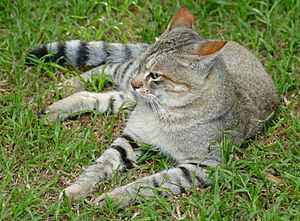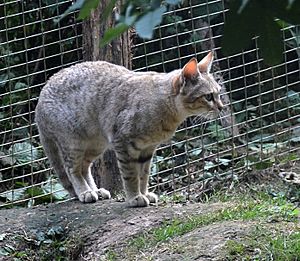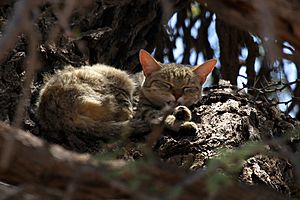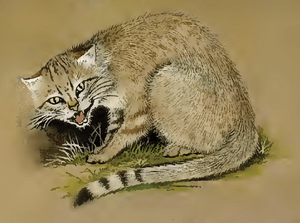African wildcat facts for kids
Quick facts for kids African wildcat |
|
|---|---|
 |
|
| Conservation status | |
| Scientific classification | |
| Kingdom: | |
| Class: | |
| Order: | |
| Family: | |
| Genus: | |
| Species: | |
| Subspecies: |
Felis silvestris lybica
|
The African wildcat (Felis silvestris lybica) is a small, fierce cat. These wildcats live in forests, grasslands, and brush lands. You can find them in Africa and the Middle East. They are the closest living relatives of our pet domestic cats!
This wildcat subspecies lives across northern Africa. Its range also extends around the Arabian Peninsula to the Caspian Sea. It is the most common and widespread wild cat. Because of this, the IUCN lists it as Least Concern. This means it is not currently in danger.
African wildcats began to be tamed about 10,000 years ago. This happened in the Middle East. These tamed cats are the ancestors of all domestic cats we have today. Scientists found remains of domesticated cats in human burials in Cyprus. These findings date back about 9,500 years ago. Even today, domestic cats and African wildcats can have hybrid offspring.
Contents
What African Wildcats Look Like
African wildcats have light sandy grey fur. Sometimes their fur can look pale yellow or reddish. Their ears are reddish to grey. They have long, light yellow hairs around the ear flap, called the pinna.
They have dark stripes on their face. Two stripes run across their cheeks. Four to six stripes are found on their throat. A dark stripe goes along their back. Their sides are lighter, and their belly is whitish. They often have faint vertical stripes on their sides that can look like spots. Their front legs have two dark rings. Their hind legs are striped. Their feet are dark brown or black. Their fur is shorter than that of the European wildcat. African wildcats are also much smaller than European wildcats.
Male wildcats from Northern Africa are about 47–59.7 cm (18.5–23.5 in) long from head to body. Their tails are about 26.7–36.8 cm (10.5–14.5 in) long. Female wildcats are a bit smaller. They measure about 40.6–55.8 cm (16.0–22.0 in) from head to body. Their tails are about 24.1–33.7 cm (9.5–13.3 in) long.
Wildcats from Yemen are similar in size. Males are about 46–57 cm (18–22 in) long with tails of 25–32 cm (9.8–12.6 in). Females are slightly smaller. Both males and females usually weigh between 3.2 to 4.5 kg (7.1 to 9.9 lb). This is about the weight of a large house cat.
Where African Wildcats Live
The African wildcat lives across northern Africa. You can also find them in the Near East. They live around the edge of the Arabian Peninsula, reaching the Caspian Sea. In Africa, they live from Morocco to Egypt. They also live in the savannas of West Africa. This includes countries like Mauritania, Somalia, Eritrea, Ethiopia, Djibouti, and Sudan. Their range goes all the way south to South Africa.
They can live in many different places. They especially like hilly and mountainous areas. However, in deserts like the Sahara, there are fewer of them. The sand cat is much better at living in very dry deserts.
How African Wildcats Live
African wildcats are mostly active at night. This is when they hunt for food. Their hearing is very good. It helps them find prey precisely. They crawl slowly and use plants to hide. They rarely need to drink water. They mainly hunt small animals. Their diet includes mice, rats, birds, reptiles, and insects.
If an African wildcat feels threatened, it will raise its fur. This makes it look bigger. It does this to scare away opponents. During the day, they usually hide in bushes. But sometimes they are active on dark, cloudy days. A male wildcat's territory can overlap with the territories of up to three females.
Raising Young Wildcats
Female African wildcats usually give birth to one to three kittens. This often happens during the warm wet season. African wildcats often rest and have their babies in burrows. They also use hollows in the ground.
The mother carries her kittens for about 56 to 69 days. The kittens are born blind. They need their mother's full care. They stay with their mother for five to six months. They can have their own babies after about six months old.
The History of African Wildcats
Scientists studied the mitochondrial DNA of many cats. They looked at 979 domestic and wildcats from Europe, Asia, and Africa. They think the African wildcat separated from the European wildcat about 173,000 years ago. It separated from the Asiatic wildcat and Southern African wildcat about 131,000 years ago.
Around 10,000 years ago, some African wildcats were tamed. This happened in the Middle East. These tamed cats are the ancestors of all domestic cats today. Modern domestic cats come from at least five different female ancestors. African wildcats can easily have babies with wild domestic cats.
Cats were tamed in the Middle East. This might have happened in more than one place, like Egypt and Turkey. African wildcats were traded across the region. This led to different cat groups mixing their genes. Egyptian art shows how the role of cats changed. Around 1950 BCE, they were shown as hunters in fields. By 1500 BCE, they were shown as human companions. These tamed Egyptian cats are believed to be the ancestors of domestic cats.
Protecting African Wildcats
Alley Cat Rescue is an organization working to protect African wildcats. They also try to reduce "genetic pollution" from domestic cats. This happens when domestic cats and wildcats have babies together.
Domestic cats and African wildcats are very similar. Because of this, a domestic cat can act as a surrogate mother for wildcat embryos. This means a domestic cat can carry an African wildcat baby. The domestic cat's body will not reject the wildcat embryo.
Postage Stamp
The Libyan Posts worked with the World Wide Fund for Nature. They released a postage stamp featuring Felis lybica on November 1, 1997. This stamp issue was also released as a set of four stamps on a mini-sheet.
Images for kids
See also
 In Spanish: Gato montés africano para niños
In Spanish: Gato montés africano para niños











